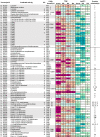Genomic and transcriptomic analysis of the thermophilic lignocellulose-degrading fungus Thielavia terrestris LPH172
- PMID: 34082802
- PMCID: PMC8176577
- DOI: 10.1186/s13068-021-01975-1
Genomic and transcriptomic analysis of the thermophilic lignocellulose-degrading fungus Thielavia terrestris LPH172
Abstract
Background: Biomass-degrading enzymes with improved activity and stability can increase substrate saccharification and make biorefineries economically feasible. Filamentous fungi are a rich source of carbohydrate-active enzymes (CAZymes) for biomass degradation. The newly isolated LPH172 strain of the thermophilic Ascomycete Thielavia terrestris has been shown to possess high xylanase and cellulase activities and tolerate low pH and high temperatures. Here, we aimed to illuminate the lignocellulose-degrading machinery and novel carbohydrate-active enzymes in LPH172 in detail.
Results: We sequenced and analyzed the 36.6-Mb genome and transcriptome of LPH172 during growth on glucose, cellulose, rice straw, and beechwood xylan. 10,128 predicted genes were found in total, which included 411 CAZy domains. Compared to other fungi, auxiliary activity (AA) domains were particularly enriched. A higher GC content was found in coding sequences compared to the overall genome, as well as a high GC3 content, which is hypothesized to contribute to thermophilicity. Primarily auxiliary activity (AA) family 9 lytic polysaccharide monooxygenase (LPMO) and glycoside hydrolase (GH) family 7 glucanase encoding genes were upregulated when LPH172 was cultivated on cellulosic substrates. Conventional hemicellulose encoding genes (GH10, GH11 and various CEs), as well as AA9 LPMOs, were upregulated when LPH172 was cultivated on xylan. The observed co-expression and co-upregulation of genes encoding AA9 LPMOs, other AA CAZymes, and (hemi)cellulases point to a complex and nuanced degradation strategy.
Conclusions: Our analysis of the genome and transcriptome of T. terrestris LPH172 elucidates the enzyme arsenal that the fungus uses to degrade lignocellulosic substrates. The study provides the basis for future characterization of potential new enzymes for industrial biomass saccharification.
Keywords: Biomass degradation; Carbohydrate active enzymes; Cellulose; Filamentous fungi; LPMO; Thermostable enzymes; Transcriptome; Xylan.
Conflict of interest statement
The authors declare that they have no competing interests.
Figures




Similar articles
-
Insights into the Lignocellulose-Degrading Enzyme System of Humicola grisea var. thermoidea Based on Genome and Transcriptome Analysis.Microbiol Spectr. 2021 Oct 31;9(2):e0108821. doi: 10.1128/Spectrum.01088-21. Epub 2021 Sep 15. Microbiol Spectr. 2021. PMID: 34523973 Free PMC article.
-
Comparison of Six Lytic Polysaccharide Monooxygenases from Thermothielavioides terrestris Shows That Functional Variation Underlies the Multiplicity of LPMO Genes in Filamentous Fungi.Appl Environ Microbiol. 2022 Mar 22;88(6):e0009622. doi: 10.1128/aem.00096-22. Epub 2022 Jan 26. Appl Environ Microbiol. 2022. PMID: 35080911 Free PMC article.
-
Combined genome and transcriptome sequencing to investigate the plant cell wall degrading enzyme system in the thermophilic fungus Malbranchea cinnamomea.Biotechnol Biofuels. 2017 Nov 13;10:265. doi: 10.1186/s13068-017-0956-0. eCollection 2017. Biotechnol Biofuels. 2017. PMID: 29158777 Free PMC article.
-
Functional characterization of cellulose-degrading AA9 lytic polysaccharide monooxygenases and their potential exploitation.Appl Microbiol Biotechnol. 2020 Apr;104(8):3229-3243. doi: 10.1007/s00253-020-10467-5. Epub 2020 Feb 19. Appl Microbiol Biotechnol. 2020. PMID: 32076777 Review.
-
Cellulose- and xylan-degrading yeasts: Enzymes, applications and biotechnological potential.Biotechnol Adv. 2022 Oct;59:107981. doi: 10.1016/j.biotechadv.2022.107981. Epub 2022 May 14. Biotechnol Adv. 2022. PMID: 35580749 Review.
Cited by
-
Genome and secretome insights: unravelling the lignocellulolytic potential of Myceliophthora verrucosa for enhanced hydrolysis of lignocellulosic biomass.Arch Microbiol. 2024 Apr 27;206(5):236. doi: 10.1007/s00203-024-03974-w. Arch Microbiol. 2024. PMID: 38676717
-
Network Analysis Reveals Different Cellulose Degradation Strategies Across Trichoderma harzianum Strains Associated With XYR1 and CRE1.Front Genet. 2022 Feb 24;13:807243. doi: 10.3389/fgene.2022.807243. eCollection 2022. Front Genet. 2022. PMID: 35281818 Free PMC article.
-
CRISPR/Cas9 mediated gene editing of transcription factor ACE1 for enhanced cellulase production in thermophilic fungus Rasamsonia emersonii.Fungal Biol Biotechnol. 2023 Sep 1;10(1):18. doi: 10.1186/s40694-023-00165-y. Fungal Biol Biotechnol. 2023. PMID: 37658430 Free PMC article.
-
Insights into the Lignocellulose-Degrading Enzyme System of Humicola grisea var. thermoidea Based on Genome and Transcriptome Analysis.Microbiol Spectr. 2021 Oct 31;9(2):e0108821. doi: 10.1128/Spectrum.01088-21. Epub 2021 Sep 15. Microbiol Spectr. 2021. PMID: 34523973 Free PMC article.
-
Transcriptional and secretome analysis of Rasamsonia emersonii lytic polysaccharide mono-oxygenases.Appl Microbiol Biotechnol. 2024 Aug 21;108(1):444. doi: 10.1007/s00253-024-13240-0. Appl Microbiol Biotechnol. 2024. PMID: 39167166 Free PMC article.
References
Grants and funding
LinkOut - more resources
Full Text Sources
Miscellaneous

